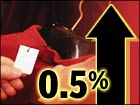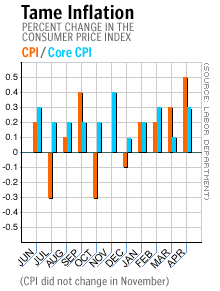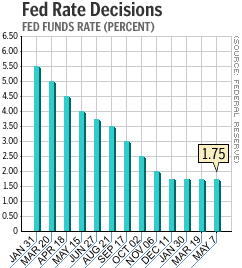
NEW YORK (CNN/Money) - Consumer prices rose in the United States in April, the government said Wednesday, and though economists were somewhat surprised by the strength of the data, they said inflation still was a distant threat.
And separate reports said industrial production gained strength in April and business inventories fell in March, as the long-suffering manufacturing sector continued to set itself right.
The Labor Department said the Consumer Price Index, the government's main inflation gauge, rose 0.5 percent in April after rising 0.3 percent in March. Economists surveyed by Briefing.com expected CPI to rise 0.4 percent.
Excluding often-volatile food and energy prices, the "core" CPI rose 0.3 percent after rising 0.1 percent in March. Economists surveyed by Briefing.com expected the core CPI to rise 0.1 percent.

"It's not as friendly as some of the other inflation numbers, but it's just one indicator," said Lehman Brothers senior economist Ethan Harris. "We have no inflation warning signals from any of the other major inflation indicators."
Separately, the Federal Reserve said industrial production rose 0.4 percent in April following a 0.5 percent increase in March. Economists surveyed by Briefing.com expected industrial production to rise 0.4 percent.
The Fed, the nation's central bank, also said factories used 75.5 percent of their capacity in April, above 75.3 percent in March and the highest level since 75.5 percent in September 2001. Economists surveyed by Briefing.com expected capacity utilization to come in at 75.6 percent.
And the Commerce Department said business inventories fell 0.3 percent in March after falling a revised 0.2 percent in February. Economists surveyed by Briefing.com expected inventories to fall 0.2 percent. It was the fourteenth straight decline in inventories.
"We know inventories are probably somewhere near the bottom," said Sung Won Sohn, chief economist at Wells Fargo & Co. "Businesses are producing [goods], trying to not only meet demand, but also to rebuild inventories."
"We're going to get an economic boost from not only production, but from inventory buildup during the current quarter, and probably for the balance of this year," Sohn added.
U.S. stock prices fell in morning trading, while Treasury bond prices were mixed.
The rise in CPI was led by a 4.5-percent jump in energy prices, following a 3.8-percent gain in March. Both months' gains were due to a spike in oil prices, driven higher by tensions in the Middle East and political turmoil in key oil producer Venezuela. Tobacco prices jumped 6.5 percent, possibly adding two-tenths of a percentage point to the headline number, according to Lehman Brothers' Harris.
Inflation has been a negligible threat in the United States for some time, thanks to surging productivity that has allowed businesses to make products at a lower cost and to a recession that began in March 2001.

"In the first year of every recovery, inflation has fallen; and we think the core CPI will fall to 2 percent by year-end," said Merrill Lynch chief economist Bruce Steinberg, referring to the 12-month percent change in CPI excluding food and energy costs, which was 2.5 percent in April.
In order to fight the recession, the Fed cut its target for short-term interest rates 11 times in 2001. It has left rates alone so far in 2002, saying the risks to the economy are balanced between a risk of inflation and a risk of further weakness.
Its key interest rate, the federal funds rate, which banks use to lend money to each other overnight, is at a 40-year low and well below the level many economists think is suitable to keep inflation at bay.
But inflation is not expected to be a threat any time soon, and many economists think the Fed is likely to keep rates lower for much of the year, or at least until the unemployment rate stops rising, in order to avoid snuffing out the nascent recovery.
"[The CPI number] doesn't have a big influence in Fed thinking," Lehman Brothers' Harris said. "This keeps [policy makers] comfortable where they are."
| |
 Related links
Related links
| |
| | |
| | |
|
In addition to unemployment, the Fed will keep an eye on business investment. At the end of the spending orgy of the late 1990s, businesses abruptly curtailed their investment in new technology and other production equipment, leaving manufacturers with a glut of unsold goods on their shelves. A long recession in manufacturing and more than a million job cuts followed, setting the stage for the downturn in the broader economy.
Businesses slashed inventories at a record pace at the end of 2001, and a continuing inventory adjustment could set the stage for a return to higher production in the future -- but only if there's demand for new products.
If that demand arises more quickly than expected, the Fed could raise rates again as soon as its August meeting.
"For a while, everybody thought there would be no increase until year-end," said Wells Fargo's Sohn. "They may hike rates sooner than we realize."

|

